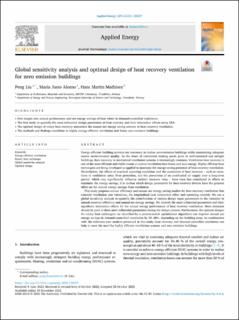| dc.contributor.author | Liu, Peng | |
| dc.contributor.author | Justo Alonso, Maria | |
| dc.contributor.author | Mathisen, Hans Martin | |
| dc.date.accessioned | 2022-11-14T08:58:21Z | |
| dc.date.available | 2022-11-14T08:58:21Z | |
| dc.date.created | 2022-11-10T13:55:42Z | |
| dc.date.issued | 2023 | |
| dc.identifier.issn | 0306-2619 | |
| dc.identifier.uri | https://hdl.handle.net/11250/3031588 | |
| dc.description.abstract | Energy-efficient building services are necessary to realise zero-emission buildings while maintaining adequate indoor environmental quality. As the share of ventilation heating needs grow in well-insulated and airtight buildings, heat recovery in mechanical ventilation systems is increasingly common. Ventilation heat recovery is one of the most efficient and viable means to reduce ventilation heat losses and save energy. Highly efficient heat exchangers are being developed or applied to maximise the energy-saving potential of heat recovery ventilation. Nevertheless, the effects of practical operating conditions and the constraints of heat recovery – such as variations in ventilation rates, frost protection, and the prevention of an overheated air supply over a long-term period, which may significantly influence realistic recovery rates – have been less considered in efforts to maximise the energy savings. It is unclear which design parameters for heat recovery devices have the greatest effect on the annual energy savings from ventilation.
This study proposes annual efficiency and annual net energy saving models for heat recovery ventilation that consider ventilation rate variations, the longitudinal heat conduction effect and operating controls. We use a global sensitivity analysis to quantify the contributions of various design input parameters to the variation in annual recovery efficiency and annual net energy savings. We identify the most influential parameters and their significant interaction effects for the annual energy performance of heat recovery ventilation. More attention should be paid to these most influential parameters during the design process. Furthermore, the optimal designs for rotary heat exchangers (as identified by a pattern-search optimisation algorithm) can improve annual net energy savings in demand-controlled ventilation by 33–48%, depending on the building areas. In combination with the reference year analysis presented in this study, heat recovery and demand-controlled ventilation can help to meet the need for highly efficient ventilation systems and zero-emission buildings. | en_US |
| dc.language.iso | eng | en_US |
| dc.rights | CC BY 4.0 | * |
| dc.rights.uri | http://creativecommons.org/licenses/by/4.0/deed.no | * |
| dc.subject | Energy-efficient ventilation | en_US |
| dc.subject | Rotary heat exchanger | en_US |
| dc.subject | Global sensitivity analysis | en_US |
| dc.subject | Optimal design | en_US |
| dc.title | Global sensitivity analysis and optimal design of heat recovery ventilation for zero emission buildings | en_US |
| dc.type | Peer reviewed | en_US |
| dc.type | Journal article | en_US |
| dc.description.version | publishedVersion | en_US |
| dc.rights.holder | © 2022 The authors | en_US |
| dc.subject.nsi | VDP::Teknologi: 500 | en_US |
| dc.source.volume | 329 | en_US |
| dc.source.journal | Applied Energy | en_US |
| dc.identifier.doi | 10.1016/j.apenergy.2022.120237 | |
| dc.identifier.cristin | 2071913 | |
| dc.relation.project | Norges forskningsråd: 257660 | en_US |
| dc.source.articlenumber | 120237 | en_US |
| cristin.ispublished | true | |
| cristin.fulltext | original | |
| cristin.qualitycode | 1 | |

